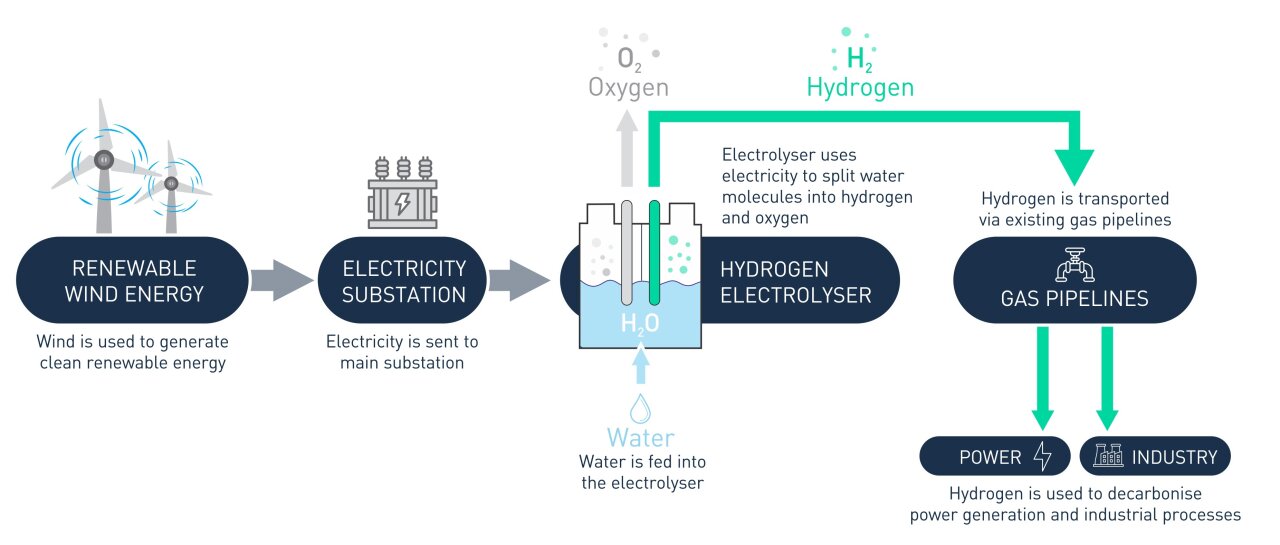FAQs
Your questions answered

What is green hydrogen?
Hydrogen is the most abundant element in the universe, making up around three-quarters of all matter. In its pure physical form, it is a colourless gas.
A range of hydrogen production methods exist, and each of these has been assigned a colour to distinguish it.
Green hydrogen is produced by using renewable electricity to split water into hydrogen and oxygen. This process is called electrolysis, with water and electricity being the key inputs. There are no carbon emissions created from this process, given the input electricity is taken from renewable sources, and it is considered the greenest of all hydrogen production methods.
What will Kintore Hydrogen’s hydrogen be used for?
The project’s hydrogen will primarily be used to help decarbonise the most energy intensive parts of the UK, such as power generation facilities and carbon intensive industrial clusters, as a replacement for natural gas. The hydrogen will be exported using existing gas pipelines which allows for large volumes to reach locations of need quickly and efficiently (compared to transportation by road, for example).
Why is this project needed?
Kintore Hydrogen can play a leading role in decarbonising the energy system and unlocking significant investment in the Scottish renewables economy.
The Scottish Government has targeted a five-fold increase in offshore wind energy generation by 2030, with the ScotWind programme supporting up to 28GW of projects in the coming years, to shift the energy system to being renewables-led.
At full capacity, the amount of energy generated in and off the shores of Scotland will far exceed local demand. There is an opportunity for Scotland to export this energy to users elsewhere in the UK. However, meeting these offshore wind targets will be challenging because of constraints in the electricity network, which needs significant upgrades to support this growth. This will not be easy to achieve quickly – it will likely take a significant amount of time and money.
To help address this challenge, Kintore Hydrogen can take surplus electricity produced by wind offshore in Scotland and turn it into hydrogen, which can then be sent through a network of gas pipelines across the country to the highest demand areas urgently needing to decarbonise, such as power generation facilities and carbon intensive industrial clusters. Consequently, the project can also help reduce the need to build additional cables and pylons by transporting this energy in the form of hydrogen gas through existing pipelines instead.
How will the project benefit local people?
Kintore Hydrogen has the potential to benefit local people by helping secure Aberdeenshire’s position at the heart of the growing green economy.
The construction and operation of Kintore Hydrogen will create a number of employment opportunities, many of which will require energy sector expertise. This should allow those existing workers wanting to transition into the green economy to make that first step. In addition, it is anticipated that there will be an apprenticeship scheme created to help those starting out in the sector.
The development of green hydrogen production facilities should also provide opportunities for local business within the Aberdeenshire area. The project will be looking to draw on a number of services including engineering, fabrication and construction, supply of materials and other professional services.
Statera intends to establish a community benefit fund as part of its proposals for Kintore Hydrogen. The design of this fund will be developed with local people and stakeholders.
Is the project safe?
Hydrogen electrolysis is a proven technology with scientific roots that go back to the end of the 18th Century. Hydrogen has long been produced and used in industrial applications in the UK, and internationally, such as in the refining, nuclear, space and compressed gas industries.
There are well-established regulations and codes of practice for the design, construction and operation of such assets, which must be adhered to in order to operate safely.
Kintore Hydrogen will comply with all relevant UK and international safety legislation and regulations, and established codes and standards in construction and operation.
The project team is working through a detailed design and engineering process, including undertaking detailed safety studies, to ensure the proposals are designed appropriately to meet or surpass all relevant legislation, regulations, codes of practice, and standards.
Why have you chosen this area for the project?
Kintore Hydrogen’s location has been carefully selected to ensure the project can access the highest volumes of Scottish offshore wind energy, an abundant supply of fresh water, and critical gas pipelines as a means of transporting the hydrogen produced away, while having as minimal detrimental impact as possible on the surrounding community.
The project is located next door to the strategically important Kintore substation, which is where a large amount of offshore wind generated electricity will transmit into. In locating Kintore Hydrogen adjacent to the substation, the electricity can be efficiently deployed in the process of electrolysis nearby with minimal electricity losses.
The River Don also runs close to the site providing an important source of water to be used in the process of electrolysis. The project has been granted a permit to extract water from the river to use in electrolysis by SEPA.
The site is also strategically located alongside major gas pipelines which are part of the national gas network, which have been used to transport North Sea gas. These can be repurposed to allow the green hydrogen produced on site to be transported for use across the country.